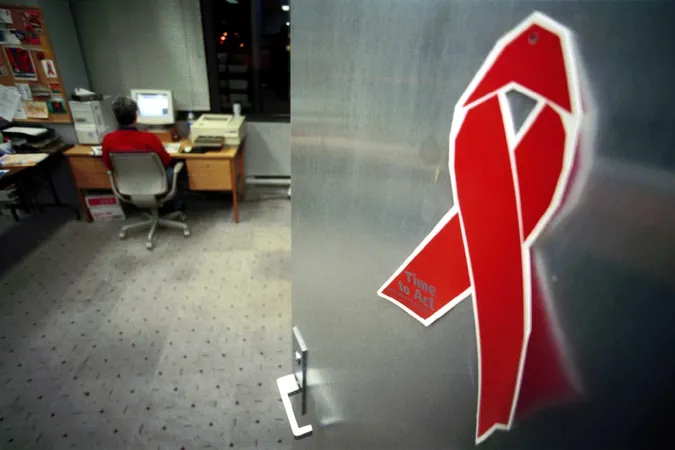
Prostate Cancer Crisis: Increasing Late-Stage Cases and Stalled Mortality Declines
2025-09-15
Author: Amelia
Dramatic Shift in Prostate Cancer Trends
The latest report from the American Cancer Society (ACS) reveals alarming new trends in prostate cancer diagnosed statistics for 2025. After years of decline, prostate cancer incidence rates have surged by 3.0% annually since 2014, reversing a previous decline of 6.4% per year from 2007 to 2014. Particularly concerning is the spike in advanced-stage diagnoses, which rose by up to 4.8% each year.
In contrast, the progress made in reducing mortality rates has markedly slowed. Previously dropping by 3% to 4% annually during the '90s and early 2000s, the decrease in deaths has plummeted to just 0.6% annually over the past decade. These critical findings were published in CA: A Cancer Journal for Clinicians.
Racial Disparities: A Troubling Reality
The report also highlights striking racial disparities. Despite general mortality declines, Black men are facing twice the mortality rates compared to their White counterparts, and Native American men show a 12% higher mortality rate despite having lower incidence.
Tyler Kratzer, the study's lead author, emphasizes the urgent need for improved understanding and treatment, stating, "This underscores the need for enhanced early detection strategies particularly for high-risk groups." He urges that all men discuss screening options with their doctors by age 50, or at 45 if they're Black or have a family history of prostate cancer.
Prostate Cancer's Toll on Men's Health
Prostate cancer remains the most prevalent cancer among American men, making up 30% of male cancer diagnoses in 2025 and ranking as the second leading cause of cancer deaths, following lung cancer. The ACS projects about 313,780 new cases and 35,770 deaths this year alone.
Survival Rates and the Age Factor
Disturbingly, distant-stage prostate cancer cases are rising across all age groups—almost 3% annually for men under 55 and 6% for those aged 55 and older. Notably, the 5-year survival rate falls to just 38% for advanced cases, contrasting starkly with nearly 100% for early-stage diagnoses.
Key Report Insights
Other significant findings include the fact that American Indian and Alaska Native men face the highest rates of diagnosis for distant-stage disease at 12%, compared to 8% among White men. The mortality rates further vary dramatically, with Black men experiencing deaths at a rate of 36.9 per 100,000, in stark contrast to just 8.8 per 100,000 for Asian American and Pacific Islander men.
State-by-state analysis shows the highest death rates in Washington, DC, and Mississippi, regions that also have high proportions of Black residents.
Necessary Action: Addressing Early Detection
As the statistics indicate an urgent need for reform, Rebecca Siegel, Senior Scientific Director at ACS, calls for improved early diagnosis practices that reach marginalized communities. She emphasizes, "Every man should have an equal shot at surviving this prevalent cancer."
Legislative Support for Prostate Cancer Screening
In response to these alarming trends, the ACS Cancer Action Network advocates for the Prostate-Specific Antigen (PSA) Screening for High-risk Insured Men (HIM) Act. This proposed federal legislation aims to eliminate out-of-pocket costs for prostate cancer screening, which can often deter men from seeking necessary tests.
Lisa A. Lacasse, President of ACS CAN, echoes the urgency for this legislation, asserting that removing financial barriers is crucial for enabling high-risk individuals to access potentially life-saving screenings. She appeals to lawmakers to act swiftly to pass this vital legislation for reducing disparities in prostate cancer diagnosis and treatment.









 Brasil (PT)
Brasil (PT)
 Canada (EN)
Canada (EN)
 Chile (ES)
Chile (ES)
 Česko (CS)
Česko (CS)
 대한민국 (KO)
대한민국 (KO)
 España (ES)
España (ES)
 France (FR)
France (FR)
 Hong Kong (EN)
Hong Kong (EN)
 Italia (IT)
Italia (IT)
 日本 (JA)
日本 (JA)
 Magyarország (HU)
Magyarország (HU)
 Norge (NO)
Norge (NO)
 Polska (PL)
Polska (PL)
 Schweiz (DE)
Schweiz (DE)
 Singapore (EN)
Singapore (EN)
 Sverige (SV)
Sverige (SV)
 Suomi (FI)
Suomi (FI)
 Türkiye (TR)
Türkiye (TR)
 الإمارات العربية المتحدة (AR)
الإمارات العربية المتحدة (AR)